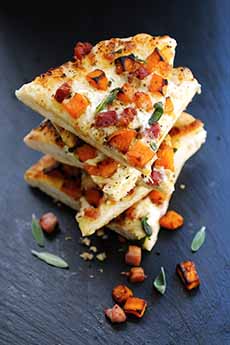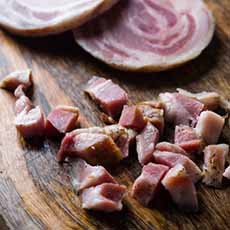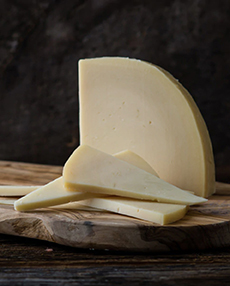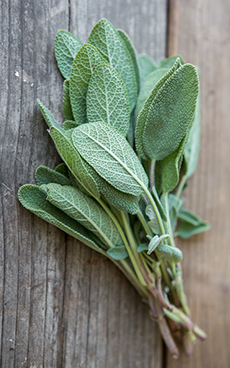RECIPE: Butternut Squash & Pancetta Pizza For Halloween
|
|
If you’ll be spending a quiet Halloween at home this year, here’s a seasonal pizza recipe from DeLallo to add some festivity to the evening (photos #1 and #3). Popular ingredients—butternut squash, pancetta and two Italian cheeses—top a pizza that’s garnished with crispy fried sage leaves. If you’ve never had them, you’ll be wanting fried sage leaves as a garnish on everything. And the good news is they complement just about everything! The recipe is below. If you can’t find pancetta, substitute bacon, Canadian bacon, prosciutto, smoked ham or smoked sausage. If you don’t know pancetta (photo #2), it’s a good time to try it. Pancetta is unsmoked bacon: pork belly that has been salt cured, spiced and air-dried for three months or longer. Pancetta: Each region of Italy has its own pancetta recipe, using their preferred spices. While there appears to be no recorded history of the origins of pancetta, there are shipping records from as early as the 15th century. The reference is to the purchase of cured meats for long voyages—and it is likely that cured meats were developed for just such a purpose [source]. Two well known types of pancetta are: This label, observed by the European Union, guarantees that the food or agricultural item, is produced in a specific geographical zone, according to traditional production techniques. Each step, from growing to packaging, is regulated. The regulations made to protect local products from competition from unauthentic products made by non-authorized producers. If you’re making the dough from scratch, you can do it up to three days in advance. For a milder flavor, buy provolone dolce (DOLE-chay) instead of the sharper provolone piccante (pee-CON-tay). Ingredients For 2 Small Pies 1. IF MAKING PIZZA DOUGH FROM SCRATCH, combine the flour mix and yeast packet in a large mixing bowl with 1-1/4 cups lukewarm water. Stir with a fork until the dough begins to form. Knead by hand for 3 minutes, or until the dough is soft and smooth. Transfer to a clean, lightly oiled bowl and cover tightly with plastic wrap. Allow the dough to rise in a warm place until doubled, about 45 minutes. After this step, you can refrigerate the dough for up to 3 days. 2. PREHEAT the oven to 450°F. Divide the dough into 2 equal pieces. Form the pizzas by hand on a lightly oiled baking pan or pizza stone. 3. DIVIDE the olive oil and toppings for each crust. First, brush the pizzas with olive oil. Next, top them with provolone cheese and small dollops of mascarpone. Sprinkle with the butternut squash and browned pancetta. 4. BAKE for 10-15 minutes, or until the crust is golden and the toppings are browned. While the pizza cooks… 5. FRY the sage leaves (instructions below). 6. TOP the pizzas with fried sage and serve. Ingredients For the pizza, select the smaller leaves from the bunch. 1. WASH and dry the sage leaves and remove stems. Be sure that the leaves are thoroughly dry before frying (when we don’t have time to air dry, we use a hair dryer!). 2. HEAT the oil in a small pan over medium-high heat. Fry the sage leaves until crisp, 2–3 seconds. Do not crowd them in the pan; fry in batches if necessary. 3. TRANSFER to paper towels to drain and sprinkle with salt. Reserve until ready to serve. |
|
|
|
||








